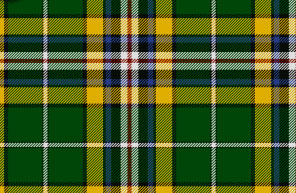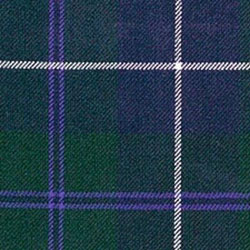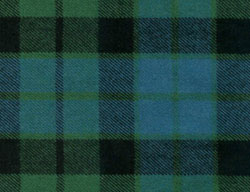Tartan plaid is a narrow, lightweight, single cloth fabric, weighing from 2 to 2% ounces per yard finished, and is composed of regular cotton yarns from 1-20s to 1-26s in warp and filling. It is always woven about 23% inches in the reed, to finish about 22 inches wide. This is done to prevent it from coming too close to the gingham lines.

Tartan plaids are generally woven with a —2/45 degree, right hand twill weave, and are always woven In plaid patterns in imitation of the Imported worsted fabric of this name. Each line of patterns has a standard name, which represents a significant style of color arrangement, such as Rob Roy, dress Stewart,Royal Stewart, Malcolm, Fraser, McGregor, Sinclair, Gordon, Drummond, Macphec-son, etc.

Those colors most used are red, green, black, white, brown, drab, wine, dark green, scarlet, dark blue, etc. IN THE ROB ROY STYLE the pattern takes the form of a broad, two-colored check, 1*4x1*4 inches, either black and red, or black and white, viz.: 72 black. 72 red in warp and filling. The dress Stewart pattern is composed principally of white yarn. The Royal Stewart has a decided red color effect. The Gordon pattern a very green color effect, etc. Aniline colors are used in dyeing the yarns for this fabric, the warp yarns being given an extra run, to insure an even shade, which, while not being exactly a fast color, is strong enough to withstand the action of a rather wet finish (gingham finish). The Fairmount 4x1 box roller loom is used for the 2, 3 and 4 shuttle tartan plaids and the Knowles 4x4 gingham loom for those styles having more than four colors in the filling. The warps for this fabric are ordered from the spinner in either 720 yards, 1,080 yards, 1.200 yards or 1,500 yards lengths, and have either 1,000 ends, 1,200 ends, 1,400 ends, or 2,000 ends, in them. The most popular are 720, or 1,080 yards,and 1,400 ends. The warp is dyed in bulk and the necessary number of ends of each color are then split off. When all the colors have been split or separated, the splittings, or separated bunches of ends of each color, are assembled in the beaming frame, and the yarn is arranged as per pattern in the rathe comb, and the warp run through this rathe on to the beam. After beaming the warp is drawn in in the regular manner. To finish this fabric, the goods are taken from the loom and run through the brasher, then through the sprinkler, after which they are very lightly sized, then run upon the tenterlng machine to prevent undue shrinkage in width, also to assist in drying, then calendered, but not to a glossy finish.
|
Carding and Spinning Particulars. The yarns used in the manufacture of tartan plaids are made in mills of the first and second diviston,as given in a previous lesson. The counts of yarn vary according to the mill in which they are made and the counts taken as examples for this article are l-22s filling j^arn and l-26s warp yarn. The cotton used for these goods is of a fair grade and a staple varying from % inch to 1 1-16 inches. We will consider the staple to be one inch. The cotton is stapled and put through a bale breaker and from here is passed by a series of lattice aprons to the mixing bin. Use as large a mixing as possible at one time, because the less mixings the evemer itihe yarp.' will be. The good waste from the machines up to the slubber is mixed into the raw stock at this point, the collections of this waste being made at regular intervals.

The raw stock is sometimes put through TWO PROCESSES OF PICKING and an opener and sometimes through three processes of picking and an opener. It has been found that two processes of picking will dean the cotton properly, and at the same time will not be so apt to put neps into it. When two processes of picking are used, the particulars of the intermediate picker given below maybe dropped. the other particulars remaining the same as given. The hopper or feed box of the opener «hotild always be kept at least half full and generally a porcupine beater is used. The speed of this beater should be about 1,050 revolutions per minute, with a fan-speed of 350 revolutions per minute. The cotton is then passed to the feed rolls of the breaker picker. Keep tlhe pin beater of this machine free from cotton, as it has to be watched to see that the sliver waste does not tangle .

THE FILLING YARN may be taken to either the mule or ring spinning room. If taken to the ring spinning room, the following are good particulars to use for frame making 22s yarn: Gauge of frame,2%; diameter of ring, 1% inches; length of traverse, 6^4inehes; twist per inch, 15.-25; speed of spindles, 7,400 revolutions per minute. For a warp frame spinning 26s use gauge of frame, 2% inches; diameter of ring, 1% inches; length of traverse, 6 inches: speed of spindles, 9,700 revolutions per minute. The warp yarn is then spooled, warped and put through a slasher.

|
Dyeing Particulars
RED. 4 per cent diamine fast red F, 30 per cent Glauber's, 3 per cent sal soda.
GREEN. 1% per cent diamine sky blue FF, 1% per cent diamine fast yellow FF, 30 per cemt Glauber's, 3 per cent sal soda.
BLACK. 15 per cent thion black G, 15 per cent sulphide soda, 30 per cent salt; 3 per cent soda ash.
BROWN. 5 per cent benzo fast orange S, 2 per cent chrysophenine, 2V2 per cent benzo fast black, 30 per cent salt, 2 per cent soda ash.
DRAB. % per cent benzo fast black, % per cent chrysophenine, 3 ounces benzo fast red G L, 30 per cent Glauber's, 2 per cent sal soda.
SLATE. % per cent benzo fast black, 'A ounce chrysophenine. A ounce benzo fast red GL, 3n per cent Glauber's, 2 per cent sal soda. |
SCARLET. 5 per cent diamine scarlet B, 30 per cemt Glauber's, 2 per cent sal soda.
DARK GREEN. 6 per cent diamine black HW, 4 per cant diamine fast yellow B, 30 per cent Glauber's, 2 per cent sal soda.
WINE. 6 per cent diamine Bordeau B, 30 per cent Glauber's, 3 per cent sal soda.
BLUE. 4 per cent brilliant benzo blue 6 B, 30 per cent Glauber's, 3 per cent sal soda.
DARK BLUB. 15 per cent pyrog'ene indigo B, 15 per cent sodium sulphide, 30 per cent salt, 3 per cent soda ash, 2 pints mineral oil.
YELLOW. 2 per cemt chloramine yellow M, 30 per cent Glauber's, 2 per oenit soda ash. |

